Blog
Our Top Blog Posts
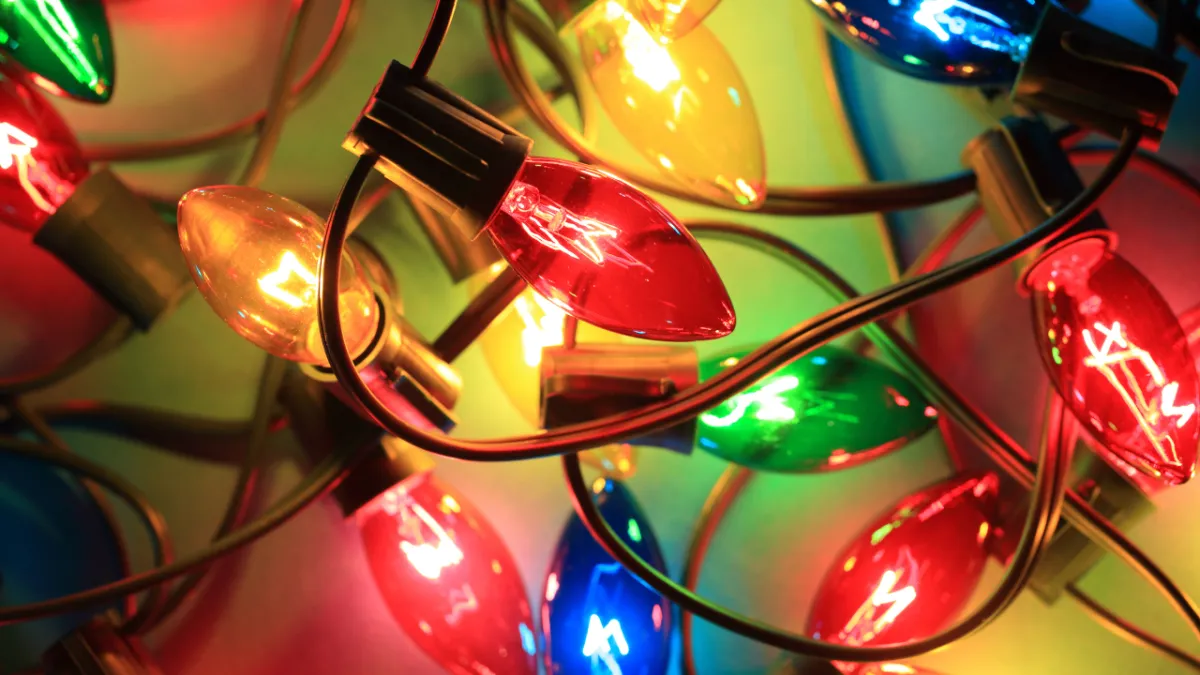
Understanding Christmas Lights Wattage: A Guide to Efficient Power Consumption
As the festive season approaches, illuminating your home with beautiful Christmas lights is a tradition that brings joy and warmth. However, managing the power consumption of your holiday decorations can often seem daunting. In this comprehensive guide, we'll simplify the process of calculating wattage for your Christmas lights, ensuring you can enjoy a brightly lit home without the stress of high energy bills or electrical concerns. From basic wattage calculations to tackling common electrical questions, we've got you covered with all the insights you need to light up your holidays efficiently and safely.
Choosing Between LED and Incandescent
When deciding how to illuminate your home for the holidays, the type of lights you choose can significantly impact both the aesthetics and logistics of your installation. Let’s explore a practical scenario involving a homeowner needing to light up 265 feet of their property.
Choosing the Right Type of Lights
For a house requiring 265 feet of lights, the homeowner has two main options: LED or incandescent lights. While both choices offer distinct visual appeal, they differ greatly in terms of electrical needs and installation requirements:
- LED Lights: These are known for their energy efficiency and longevity. If the homeowner opts for LED lights, they can connect all 265 feet end-to-end and power them through a single plug. This not only simplifies the installation process but also significantly reduces energy consumption. Despite their higher upfront cost, LED lights consume far less power—only about 38 watts for the entire length.
- Incandescent Lights: These traditional lights are less expensive initially but consume more power. In this scenario, the homeowner would need to divide the lights into six separate strings, each requiring its own outlet. Furthermore, to avoid overloading the electrical system, it's crucial to distribute these strings across at least two different household circuits. The total wattage for using incandescent lights would be a substantial 1,925 watts.
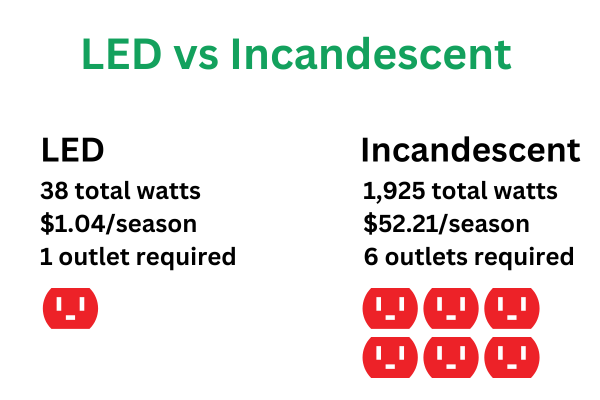
Weighing the Options
While both lighting options can create a festive and inviting atmosphere, they come with different considerations for installation and ongoing costs:
- Cost-Effectiveness: LED lights, though more expensive upfront, can offer significant savings on electricity bills due to their low wattage use.
- Installation Complexity: Installing incandescent lights involves more planning regarding outlet availability and circuit capacity. This option might require a professional consultation to ensure safety, especially in older homes with less robust electrical systems.
- Aesthetic and Functional Longevity: LED lights not only use less energy but also last longer than incandescent bulbs, reducing the frequency of replacements.
The decision between LED and incandescent lights ultimately depends on the homeowner’s priorities—whether they value initial savings or long-term efficiency and convenience. In either case, understanding the electrical implications and preparing accordingly is key to a successful and safe holiday light display.
By considering both the immediate and ongoing impacts of their choice, homeowners can ensure their holiday lighting enhances their home’s festive spirit without causing undue stress or expense.
Understanding Christmas Lights Wattage and Amps
When setting up your holiday decorations, it’s crucial to have a clear understanding of the wattage and amps associated with your Christmas lights. This knowledge not only aids in creating a stunning display but also ensures it operates safely without overloading your electrical system.
The Role of Wattage and Amps in Christmas Lighting
Wattage refers to the power consumption of your lights, and understanding this can significantly impact the planning and installation phases of your holiday display. Each bulb on a string of Christmas lights has a specific wattage, and the total wattage of the string is a key factor in determining how many strings you can safely connect and how they will affect your home’s electrical capacity.
Amps, or amperes, measure the electrical current flowing through your lights. Knowing the amp draw of your Christmas lights is essential to ensure that the circuit you plan to use can handle the load. Overloading a circuit can lead to tripped breakers and potential fire hazards.
Calculating Wattage and Amps for Safe Installation
1. Maximum Watt Capacity of String Lights:
Each string of Christmas lights has a maximum wattage capacity, typically listed on the packaging or in the product specifications. To prevent overheating and potential damage, it’s important not to exceed this capacity when connecting multiple strings of lights together.
2. Maximum Watt Capacity of House Circuits:
Most residential circuits are rated for either 15 or 20 amps, which translates to a maximum wattage of approximately 1,800 watts for 15 amps and 2,400 watts for 20 amps. However, it’s recommended to use only up to 80% of this capacity to avoid circuit overloads. This means you should aim for a maximum of 1,440 watts on a 15-amp circuit and 1,920 watts on a 20-amp circuit.
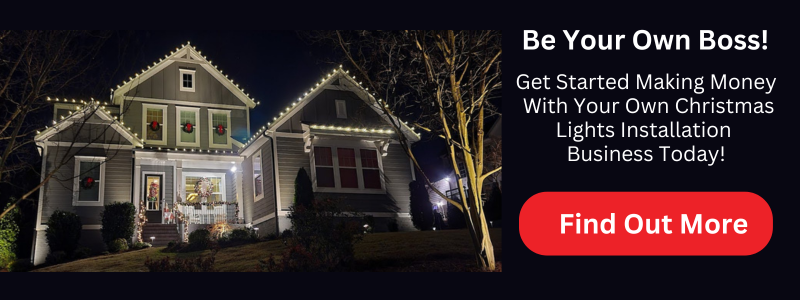
Practical Tips for Managing Wattage and Amps
- Check Your Light Specs: Before purchasing or installing Christmas lights, check the wattage per bulb and calculate the total wattage for each string. Also, check the amp draw, which is usually a function of total wattage divided by your household voltage (120 volts in the U.S).
- Plan Your Layout: Based on the wattage and amps calculation, plan how many strings you can connect end-to-end and how they will be distributed across different circuits in your home.
- Use a Circuit Tester: A simple circuit tester can help you identify which outlets are on which circuits and whether they are already nearing capacity with other household appliances.
- Consider LED Lights: LED Christmas lights consume far less power than traditional incandescent bulbs, allowing you to use more lights with less risk of overloading your circuits. They are also cooler, reducing the risk of overheating.
By thoroughly understanding and managing the wattage and amps of your Christmas lights, you can ensure that your holiday lighting is not only breathtaking but also safely installed. This preparation allows you to enjoy the holiday season with peace of mind, knowing your display is as safe as it is spectacular.
Understanding String Lights Capacity
As you plan your dazzling Christmas light display, understanding the maximum capacity of your string lights is crucial to both achieving the desired effect and ensuring safety. This capacity varies significantly between different types of lights, such as LED versus incandescent, and affects how many sets you can connect end-to-end.
The Difference Between LED and Incandescent String Lights
LED Christmas lights are highly efficient, consuming much less electricity compared to their incandescent counterparts. This efficiency allows you to connect a larger number of LED light sets together—sometimes more than 80 sets—without exceeding the maximum wattage capacity. On the other hand, traditional incandescent lights generally permit connecting only about four sets end-to-end before reaching their capacity limit.
Why String Lights Have Maximum Capacity
The maximum wattage capacity for string lights is a crucial safety feature designed to prevent electrical overloads. Overloading string lights can lead to excessive heat buildup, potential damage, or even fire hazards. To prevent these risks, most string lights are equipped with fuses that will blow if the wattage capacity is exceeded, thereby cutting off power to prevent damage to the lights and maintain safety.
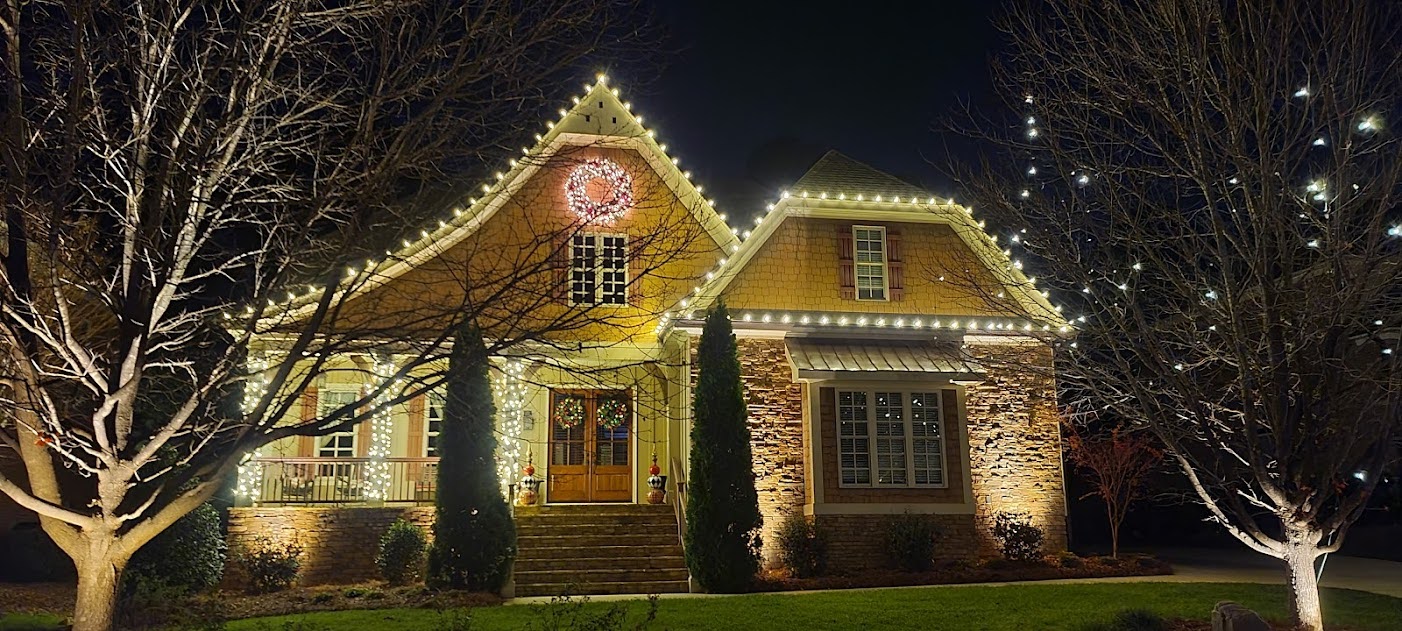
Choosing the Right String Lights for Your Display
When selecting string lights for your holiday display, consider the following:
- Check the Wattage: Always check the wattage per string and calculate the total wattage you will be drawing if multiple strings are connected. This ensures you stay within the safe operating limits.
- Count the Connectable Sets: Manufacturers typically specify the number of sets that can be safely connected end-to-end. Adhere to these guidelines to avoid overloading.
- Plan Your Power Sources: Consider where you will plug in your lights. Ensure that the outlet you plan to use can handle the load, especially if multiple strings are connected. Distribute the load across multiple circuits if necessary to balance the electrical draw.
- Fuse Safety: Understand the role of the built-in fuses within your string lights. These fuses are a fail-safe against potential overloads. Ensure you have spare fuses on hand in case they blow, and know how to replace them correctly.
Best Practices for Installation
- Spread Out Connections: Rather than maxing out the number of connectable sets per single power source, consider spreading them out to different outlets to balance the load on your home’s electrical system.
- Use a Power Strip with a Built-in Circuit Breaker: This can provide an additional layer of safety by automatically cutting power if the load becomes too high.
- Regular Inspections: Once your lights are up, inspect them periodically throughout the season for signs of wear or overheating, particularly at connection points.
By understanding the maximum capacity of your string lights and planning accordingly, you can create a safe and stunning holiday lighting display. This knowledge not only helps in creating an enchanting atmosphere but also ensures that the festive cheer isn’t cut short by electrical issues.

Understanding Circuit Capacity for Safe Christmas Light Installation
When it comes to installing Christmas lights, one critical factor often overlooked is the maximum watt capacity of your home’s plug circuits. The capacity of these circuits determines how many lights and other decorations you can safely run without risking electrical issues.
How Household Circuits Work
A typical household circuit may power several outlets, internal lighting fixtures, and built-in appliances. This means that when you plug your Christmas lights into an outlet, they share the circuit's total capacity with everything else currently drawing power. The availability of wattage for your lights heavily depends on how much power is already being used by other devices on the same circuit.
The Risk of Overloading Circuits
If there are few appliances or devices on a circuit, you'll have a greater capacity to add Christmas lights without issues. However, if many items are drawing power, adding your holiday lights could push the circuit beyond its safe limit, leading to tripped circuit breakers in your fuse box. This happens when the total wattage used exceeds what the circuit can handle, measured in amps.
Key Numbers to Know
Most home circuits are rated for either 15 or 20 amps. Electrical safety standards recommend that you should never exceed 80% of a circuit’s maximum capacity to avoid overloads. Here’s what this means in practical terms:
- 15 Amp Circuits: These can support up to 1,800 watts, but for safety, you should limit your usage to no more than 1,440 watts on these circuits.
- 20 Amp Circuits: These circuits can handle up to 2,400 watts, with a safe usage limit of 1,920 watts.
How to Manage Your Light Display
To ensure that you do not exceed these limits, consider the following tips:
- Calculate Total Wattage: Before setting up your lights, calculate the total wattage that your display will require. Include all light strands, inflatable decorations, and any other electrically powered decorations.
- Check What’s Already Using the Circuit: Identify which appliances and devices are on the same circuit as where you plan to connect your lights. You may need to unplug some items or use a different circuit to balance the load.
- Use Multiple Circuits: If your light display requires more power than what one circuit can safely provide, spread your lights across multiple circuits to distribute the load.
- Monitor Circuit Load: Consider using a watt meter to monitor the actual wattage being used by your Christmas lights. This can help prevent accidental overloads and give you real-time feedback on your electrical usage.
By understanding and managing the maximum watt capacity of your circuits, you can enjoy a brightly lit home for the holidays without the worry of tripping breakers or causing electrical hazards. It’s an essential step in ensuring both the beauty and safety of your festive light display.
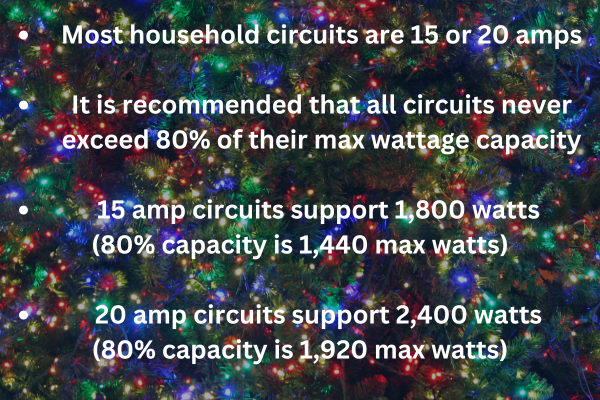
Calculating the Energy Usage of Your Christmas Lights
Understanding the wattage of your Christmas lights is crucial for both planning your holiday display and managing your energy consumption efficiently. Wattage, the measure of energy usage, is typically indicated per bulb or per string and can usually be found on the bulb itself or near the UL tags on the string. If this information is not readily available, a wattage meter can be purchased for around $10 to help you calculate the electrical draw of your lights.
Incandescent vs. LED Lights
While both incandescent and LED lights are popular choices for holiday decorations, they have significantly different energy requirements:
- Incandescent Lights: These traditional lights consume more electricity. If you’re using incandescent lights, you’ll need to be mindful of the total wattage, especially when connecting multiple strings, to avoid overloading your electrical system.
- LED Lights: LEDs are much more energy-efficient. They use a fraction of the electricity compared to incandescent bulbs, allowing you to connect more strings end-to-end without nearing your circuit’s capacity.
Real-Life Mini Light Wattage Scenario
Consider a typical decoration project where mini lights are used to adorn porch railings, columns, or windows. Inside the home, these lights might also decorate trees, mantles, or stair railings. For instance, using 1,000 incandescent mini lights would consume approximately 408 watts. In contrast, the same number of LED mini lights would only use about 69 watts.
- Connecting Sets: Incandescent mini lights usually allow only up to 5 sets to be connected end-to-end, requiring multiple outlets to avoid overloading. On the other hand, up to 43 sets of LED mini lights can be connected end-to-end using just one outlet due to their lower power requirements.
Planning for Your Display
Using the example of mini lights, if you plan to use over 40 sets to decorate outdoor bushes, trees, or landscaped areas:
- Incandescent Mini Lights: You would need to plan for 8 separate plug outlets to accommodate the higher energy use without overloading your circuits.
- LED Mini Lights: Despite the higher number of strings, you would still only require one plug outlet, thanks to their efficient power usage.
Choosing the Right Lights
The choice between incandescent and LED lights ultimately depends on your specific needs and preferences. Both types of lights can create a stunning holiday display, but it's crucial to plan accordingly:
- For Incandescent Lights: Careful electrical planning is necessary to ensure that you do not exceed the capacity of your light strings or your home’s circuitry.
- For LED Lights: While they are more straightforward to plan due to their low energy consumption, the initial cost may be higher.
By understanding the wattage of your Christmas lights and how it impacts your electrical setup, you can create a safe and spectacular holiday display that is both beautiful and energy-efficient. Whether you choose incandescent or LED lights, proper planning will ensure that your home is the highlight of the neighborhood this festive season.
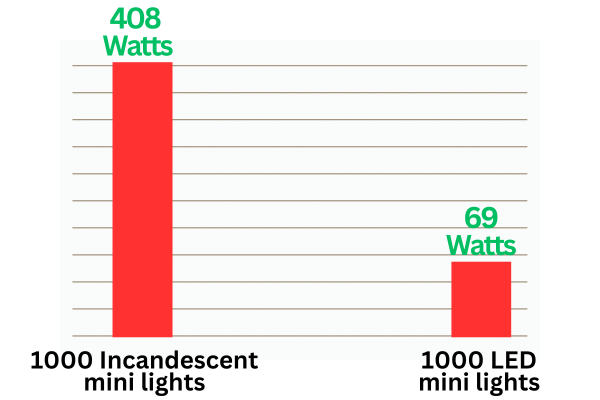
The Power Dynamics of C9 & C7 Christmas Lights
When it comes to illuminating your home's roofline during the festive season, C9 and C7 bulbs remain the go-to choices for their aesthetic appeal and visibility. However, choosing between LED and incandescent versions of these lights requires understanding their significant differences in power consumption and installation logistics.
Scenario Breakdown: C9 & C7 Light Strings
Imagine you need to cover 300 feet of your home's roofline, and you opt for the traditional 12-inch spacing, equating to 300 bulbs. The choice between incandescent and LED bulbs not only affects the visual outcome but also the electrical logistics:
- Incandescent Bulbs: Though they provide a warm, classic glow, powering 300 incandescent C9 bulbs requires a hefty 2,100 watts. This high energy requirement means you can connect only 2 strings end-to-end before needing a new power source—resulting in the need for six different outlets.
- LED Bulbs: In stark contrast, the same number of LED bulbs would only require about 29 watts. This drastic reduction in power consumption allows for up to 87 strings to be connected end-to-end. For practical purposes, you could connect all 12 strings needed for your project into a single outlet without overwhelming your home’s electrical system.
Electrical Planning Considerations
Using incandescent bulbs necessitates careful planning. Their high wattage may exceed what a standard household circuit can handle, often necessitating the use of multiple circuits to avoid tripping breakers:
- Circuit Management: If you go with incandescent bulbs, be prepared to manage multiple light runs across different circuits to prevent overloading. This often means understanding which outlets are on which circuits within your home and may involve using extension cords strategically.
- Installation Strategy: Given you can only run two incandescent strings end-to-end (50 feet max), you need to plan for numerous starting points across different power sources. This scenario might require more extensive use of extension cords or planning installations across various rooms that provide access to exterior rooflines.
Why Choose Incandescent?
Despite the logistical challenges, many choose incandescent bulbs for several reasons:
- Cost-Effectiveness: Incandescent bulbs are generally cheaper upfront compared to LEDs. For those who use holiday lights only briefly each year, the lower initial investment can be appealing.
- Aesthetic Appeal: Incandescent lights offer a unique warm glow and halo effect that many find nostalgically appealing. This traditional look is something that newer LED bulbs often struggle to replicate.
- Versatility: Many enthusiasts prefer purchasing separate bulbs and stringers for customization. This not only allows for the replacement of individual bulbs but also facilitates the use of the stringers for different purposes throughout the year, such as patio lighting in warmer months.
Advanced Planning for Year-Round Utility
Thinking ahead about how you can utilize these lighting setups beyond the Christmas season can maximize your investment. For instance, those C9 or C7 strings can brighten your backyard during summer evenings, transforming into a versatile, year-round home enhancement.
Safety and Efficiency
Lastly, it's crucial to remember the electrical limits:
- Safety First: Always ensure that your electrical setups do not exceed 80% of your circuit's capacity to avoid hazards and ensure efficiency. For a 15 amp circuit, this means no more than 1,440 watts, and for a 20 amp circuit, no more than 1,920 watts should be used.
By understanding these nuances in wattage, amp requirements, and practical installation strategies, you can safely and beautifully light up your home, making your holiday display both stunning and safe. Whether you choose the nostalgic allure of incandescent bulbs or the modern efficiency of LEDs, proper planning will lead to a successful and sparkling display.
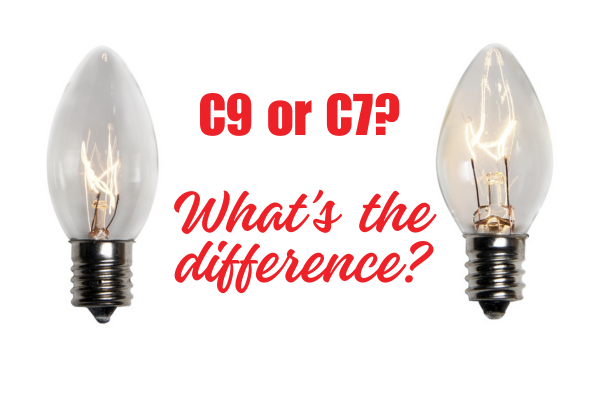
Understanding Light Wattage and Amp Capacity for Safe Christmas Light Displays
When setting up your Christmas lights, comprehending how wattage and amp capacity interact is crucial for creating a safe and stunning holiday display. This section explains the relationship between these electrical concepts and provides guidance on managing them effectively during your festive decorations.
Wattage and Amp Capacity: The Basics
- Wattage: This is a measure of energy used by your Christmas lights. It dictates how much power your light strings draw from the electrical source.
- Amps: This unit measures electrical current. Knowing the amp capacity is essential to ensuring that your light display operates safely without overloading your home’s electrical system.
Amp Capacity in String Lights
For those who enjoy customizing their holiday lights, amp capacity in string lights is a key consideration:
- Customizable Lighting: When C7 or C9 bulbs and stringers are sold separately, you have the flexibility to create a tailored lighting arrangement. However, it’s vital to know the amp capacity of the stringers or spools, which is typically listed in the product specifications.
- Safety Margin: To prevent overheating and ensure your lights function flawlessly all season, it's recommended to utilize no more than 80% of the string’s listed amp capacity. This precaution helps avoid electrical issues and prolongs the life of your lights.
Amp Capacity in Household Circuits
Understanding the amp capacity of your household circuits is equally important:
- Circuit Capacity: Each circuit in your home can support a specific total wattage, irrespective of the number of outlets it contains. All devices and lights connected to a single circuit share its total amp capacity.
- Managing Load: Consider other appliances or devices running on the same circuit as your Christmas lights, such as lamps or electronics. Ensuring that the combined usage stays within 80% of the circuit’s amp capacity is crucial to prevent tripping breakers.
Calculating Amps for Christmas Lights
If your Christmas lights’ packaging or the UL tag specifies total amps along with watts, you’re immediately aware of the current they draw. However, if only wattage is provided, you can calculate the amps as follows:
- Formula: Divide the total wattage by 120 volts (the standard voltage for US household outlets) to find the total amps. For example, if your total wattage is 240 watts, dividing this by 120 volts gives you 2 amps.
This understanding of how wattage relates to amp capacity is essential not just for the safety of your lighting display, but also for the efficiency and longevity of your Christmas decorations. By carefully planning and calculating these elements, you can ensure that your home is safely and beautifully lit for the holiday season.
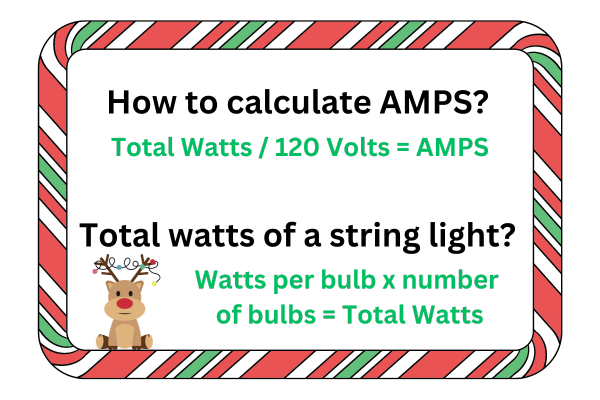
How Many Lights Can You Safely Connect?
When it comes to adorning your home with sparkling lights for the holidays, it's crucial to know how many Christmas light strings you can safely string together. This ensures that your festive display is not only breathtaking but also safe from electrical hazards.
Understanding UL Standards for Christmas Lights
Christmas Lights, Etc adheres to the UL (Underwriters Laboratories) standards, which set clear guidelines on the maximum number of light strings that can be connected end-to-end:
- 22 Gauge Wire: With this wire thickness, you can connect light strings that cumulatively do not exceed 210 watts.
- 20 Gauge Wire: For a slightly thicker wire, the limit increases to 420 watts of connected light strings.
This guidance is crucial for preventing circuit overloads and ensuring that your light display operates safely throughout the holiday season.
Quick Reference Chart for Connecting Christmas Light Strings
To help visualize the implications of these guidelines, here's a simplified reference chart that includes examples of popular Christmas light strings along with their wattage and the maximum number that can be connected:

Note: The numbers in the table are illustrative and based on typical wattages; always check the specific wattage of your chosen lights.
LED vs. Incandescent: A Consideration for Capacity
While both LED and incandescent Christmas lights can be used for any lighting application, it’s essential to consider their power requirements:
- LED Lights: These are more energy-efficient and consume less power, allowing you to connect more strings together without exceeding UL wattage limits.
- Incandescent Lights: These traditional lights consume more power, necessitating careful planning to ensure that both the string capacity and the overall circuit capacity are not exceeded.
Using this knowledge, you can plan your holiday decorations to achieve the maximum brightness and coverage while staying within safe electrical parameters. By understanding and applying these standards, you ensure that your holiday lighting is both spectacular and secure.
Embracing Efficiency: The Power-Saving Benefits of LED Christmas Lights
During the festive season, the beauty of Christmas lights transforms homes and landscapes into magical winter wonderlands. However, the enchantment comes at a cost—power consumption. This raises a crucial question: how much power can you actually save by switching to LED Christmas lights?
The Efficiency of LED Lighting
LED Christmas lights are celebrated not only for their vibrancy and durability but also for their incredible efficiency compared to traditional incandescent lights:
- Lower Wattage: LED lights consume significantly less power. Where incandescent bulbs might use up to ten times more wattage for the same number of lights, LEDs shine brighter with far less energy.
- Cool Operation: Unlike their incandescent counterparts, LED lights remain cool to the touch throughout their operation. This feature not only reduces the risk of fire hazards but also contributes to their energy efficiency.
Cost-Effective Holiday Decorating
Investing in LED Christmas lights can lead to substantial savings on your electricity bills. Consider these points:
- Extended Lifespan: LED strings typically boast a life expectancy of over 50,000 hours compared to just 3,000 hours for standard incandescent bulbs. This longevity means fewer replacements and less waste.
- Durability: LEDs are more robust and less prone to breakage, further enhancing their cost-effectiveness and appeal as a long-term holiday lighting solution.
Sustainable Holiday Cheer
Switching to LED Christmas lights is not just a financial decision; it's a step towards more sustainable holiday decorations. By consuming less power, these lights help reduce your carbon footprint, making your holiday season greener.
Learn More About LED Christmas Lights
For those interested in deeper insights into the benefits and varieties of LED Christmas lights, our comprehensive blog post: Everything You Need To Know About LED Christmas Lights provides detailed information on selecting and maximizing the use of LEDs in your holiday decor. Whether you’re lighting up a small apartment or an expansive landscape, LEDs offer a brilliant yet efficient solution to your festive lighting needs.
By adopting LED technology for your Christmas decorations, you not only enhance the visual appeal of your holiday setup but also contribute to energy conservation, ensuring that the spirit of the season is celebrated sustainably.
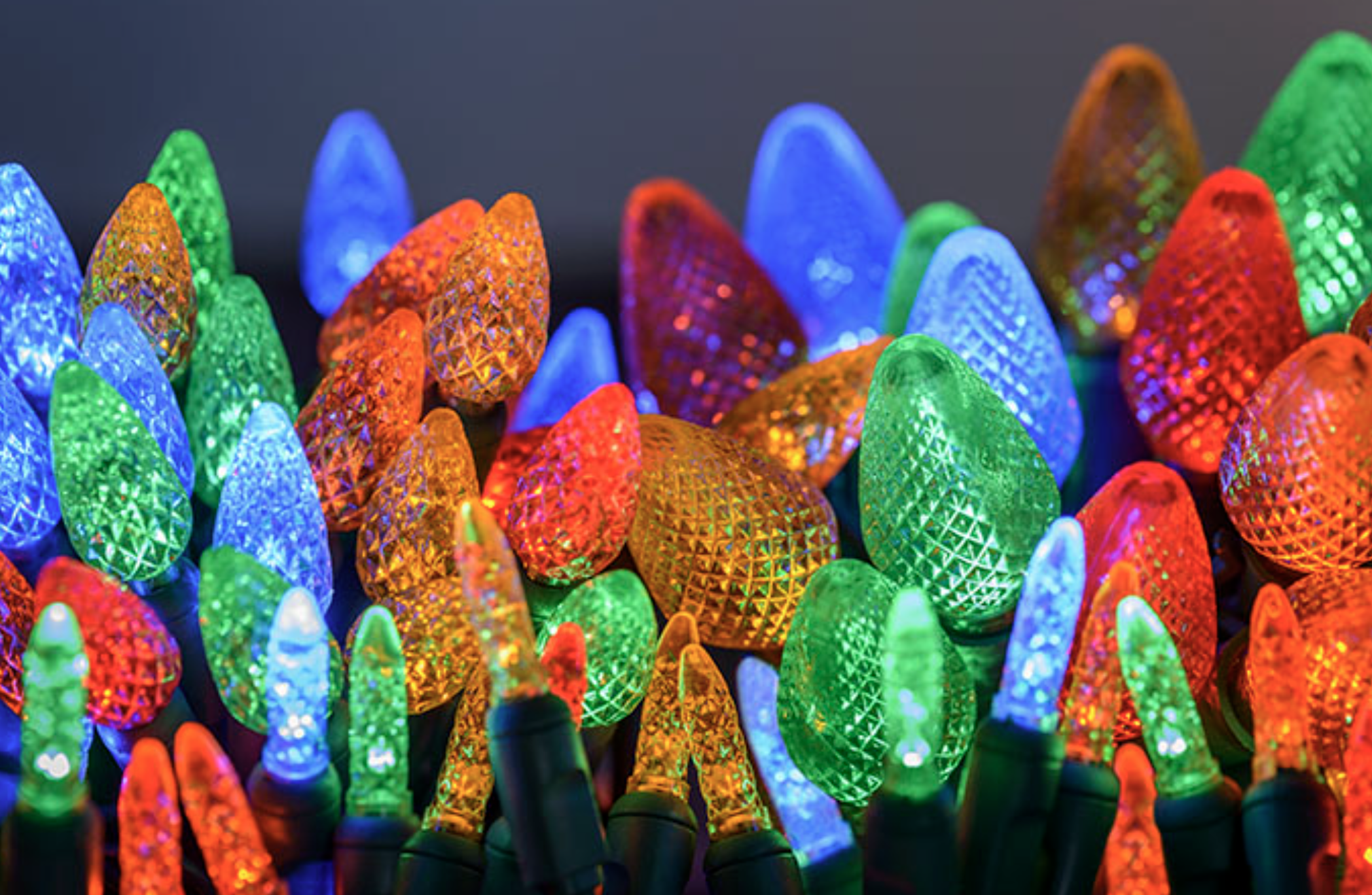
Maximizing Efficiency with Timers for Christmas Lights
Incorporating timers into your Christmas lighting setup is an effective strategy to enhance energy efficiency during the festive season. Timers play a pivotal role in managing the duration your lights are on, which not only saves power but also extends the life of your lights. Here’s how using a timer can contribute to more sustainable holiday decorations:
Scheduling Your Light Display
Timers allow you to control precisely when your Christmas lights turn on and off. This control means that lights aren't left running all night unnecessarily, reducing energy consumption significantly. For example, setting the timer to illuminate your display from dusk until midnight can capture the peak evening hours without wasting electricity when fewer people are likely to appreciate the display.
Choosing the Right Timer
When integrating a timer into your lighting system, it's crucial to consider the following:
- Amp Capacity: Ensure that the timer's amp capacity matches or exceeds the total amp draw of your Christmas lights. This is to ensure that the timer can handle the electrical load without any safety hazards.
- Compatibility with Your Circuit: It’s important to remember that a timer does not increase the amp capacity of your electrical circuit. If you're using a 15-amp timer, the total load on your circuit—including the lights and any other devices—should not exceed the 15 amps available. This precaution helps avoid tripping breakers or potential electrical fires.
Installation and Usage Tips
Setting up a timer is generally straightforward, but here are a few tips to ensure optimal performance:
- Location: Install the timer in a location where it is easily accessible and can be adjusted as needed for changes in your schedule or lighting preferences.
- Check Ratings: Always check that the timer is suitable for outdoor use if it will be exposed to the elements, and confirm that it has the necessary weatherproofing to withstand winter conditions.
Energy Savings and Convenience
Beyond energy savings, using a timer adds a level of convenience to your holiday setup. It eliminates the need to manually turn lights on and off, which can be especially beneficial during the hectic holiday season. Automating your light display ensures that your home is lit up at the right times, enhancing both the beauty and the efficiency of your holiday decorations.
By implementing a timer, you’re not just saving power; you’re also adopting a smarter, more practical approach to holiday decorating. This simple addition to your Christmas light setup can make a significant difference in both your electricity bills and your overall holiday experience, letting you enjoy the festive cheer without any added hassle or expense.

1. What are the main differences between LED and incandescent Christmas lights?
- LED lights are more energy-efficient, using significantly less power and can be strung in longer sequences from a single power source. Incandescent lights, though less expensive initially, consume more power and require multiple power sources to prevent circuit overloading.
2. Can I connect all my LED Christmas lights to one plug?
- Yes, if you opt for LED lights, you can connect all 265 feet of lights end-to-end and power them through a single plug due to their low power consumption.
3. How many incandescent light strings do I need for 265 feet?
- For incandescent lights, you would need to divide the total length into six separate strings, each powered by its own outlet, and ensure they are distributed across at least two different household circuits.
4. What are the wattage usages of LED versus incandescent lights for 265 feet?
- LED lights for 265 feet would only use about 38 watts, whereas incandescent lights would use approximately 1,925 watts.
5. What should I consider when choosing between LED and incandescent Christmas lights?
- Consider the cost-effectiveness, installation complexity, and aesthetic and functional longevity. LEDs offer long-term savings and simpler installation but have a higher upfront cost. Incandescent lights are cheaper initially but cost more in long-term energy usage and installation complexity.
6. What installation challenges might I face with incandescent lights?
- Installing incandescent lights involves more planning regarding outlet availability and circuit capacity, possibly requiring a professional to ensure safety, especially in older homes.
7. How do I calculate the number of lights I need for my house?
- Measure the length of the area you want to decorate and choose your lighting type. For precision, use a tape measure to ensure you cover all desired areas and purchase sufficient strings of lights to cover the length.
8. What are the benefits of using timers with my Christmas lights?
- Timers allow your lights to operate only at optimal viewing times, saving energy by turning them off automatically when not needed. This not only reduces your electricity bill but also extends the life of your lights.
9. How do I ensure my Christmas lights installation is safe?
- Use the correct type of lights and accessories specified for outdoor use, calculate the total wattage and amperage to avoid overloading circuits, and ensure all products are properly rated and installed according to manufacturer guidelines.
10. Where can I find the right accessories for hanging my Christmas lights?
- Check online retailers or local stores for a range of Christmas light clips, timers, and other accessories. Make sure to select the ones that best fit your installation surface type, like roofline, gutters, or shingles.

Understanding Christmas Lights Wattage: A Guide to Efficient Power Consumption
As the festive season approaches, illuminating your home with beautiful Christmas lights is a tradition that brings joy and warmth. However, managing the power consumption of your holiday decorations can often seem daunting. In this comprehensive guide, we'll simplify the process of calculating wattage for your Christmas lights, ensuring you can enjoy a brightly lit home without the stress of high energy bills or electrical concerns. From basic wattage calculations to tackling common electrical questions, we've got you covered with all the insights you need to light up your holidays efficiently and safely.
Choosing Between LED and Incandescent
When deciding how to illuminate your home for the holidays, the type of lights you choose can significantly impact both the aesthetics and logistics of your installation. Let’s explore a practical scenario involving a homeowner needing to light up 265 feet of their property.
Choosing the Right Type of Lights
For a house requiring 265 feet of lights, the homeowner has two main options: LED or incandescent lights. While both choices offer distinct visual appeal, they differ greatly in terms of electrical needs and installation requirements:
- LED Lights: These are known for their energy efficiency and longevity. If the homeowner opts for LED lights, they can connect all 265 feet end-to-end and power them through a single plug. This not only simplifies the installation process but also significantly reduces energy consumption. Despite their higher upfront cost, LED lights consume far less power—only about 38 watts for the entire length.
- Incandescent Lights: These traditional lights are less expensive initially but consume more power. In this scenario, the homeowner would need to divide the lights into six separate strings, each requiring its own outlet. Furthermore, to avoid overloading the electrical system, it's crucial to distribute these strings across at least two different household circuits. The total wattage for using incandescent lights would be a substantial 1,925 watts.

Weighing the Options
While both lighting options can create a festive and inviting atmosphere, they come with different considerations for installation and ongoing costs:
- Cost-Effectiveness: LED lights, though more expensive upfront, can offer significant savings on electricity bills due to their low wattage use.
- Installation Complexity: Installing incandescent lights involves more planning regarding outlet availability and circuit capacity. This option might require a professional consultation to ensure safety, especially in older homes with less robust electrical systems.
- Aesthetic and Functional Longevity: LED lights not only use less energy but also last longer than incandescent bulbs, reducing the frequency of replacements.
The decision between LED and incandescent lights ultimately depends on the homeowner’s priorities—whether they value initial savings or long-term efficiency and convenience. In either case, understanding the electrical implications and preparing accordingly is key to a successful and safe holiday light display.
By considering both the immediate and ongoing impacts of their choice, homeowners can ensure their holiday lighting enhances their home’s festive spirit without causing undue stress or expense.
Understanding Christmas Lights Wattage and Amps
When setting up your holiday decorations, it’s crucial to have a clear understanding of the wattage and amps associated with your Christmas lights. This knowledge not only aids in creating a stunning display but also ensures it operates safely without overloading your electrical system.
The Role of Wattage and Amps in Christmas Lighting
Wattage refers to the power consumption of your lights, and understanding this can significantly impact the planning and installation phases of your holiday display. Each bulb on a string of Christmas lights has a specific wattage, and the total wattage of the string is a key factor in determining how many strings you can safely connect and how they will affect your home’s electrical capacity.
Amps, or amperes, measure the electrical current flowing through your lights. Knowing the amp draw of your Christmas lights is essential to ensure that the circuit you plan to use can handle the load. Overloading a circuit can lead to tripped breakers and potential fire hazards.
Calculating Wattage and Amps for Safe Installation
1. Maximum Watt Capacity of String Lights:
Each string of Christmas lights has a maximum wattage capacity, typically listed on the packaging or in the product specifications. To prevent overheating and potential damage, it’s important not to exceed this capacity when connecting multiple strings of lights together.
2. Maximum Watt Capacity of House Circuits:
Most residential circuits are rated for either 15 or 20 amps, which translates to a maximum wattage of approximately 1,800 watts for 15 amps and 2,400 watts for 20 amps. However, it’s recommended to use only up to 80% of this capacity to avoid circuit overloads. This means you should aim for a maximum of 1,440 watts on a 15-amp circuit and 1,920 watts on a 20-amp circuit.

Practical Tips for Managing Wattage and Amps
- Check Your Light Specs: Before purchasing or installing Christmas lights, check the wattage per bulb and calculate the total wattage for each string. Also, check the amp draw, which is usually a function of total wattage divided by your household voltage (120 volts in the U.S).
- Plan Your Layout: Based on the wattage and amps calculation, plan how many strings you can connect end-to-end and how they will be distributed across different circuits in your home.
- Use a Circuit Tester: A simple circuit tester can help you identify which outlets are on which circuits and whether they are already nearing capacity with other household appliances.
- Consider LED Lights: LED Christmas lights consume far less power than traditional incandescent bulbs, allowing you to use more lights with less risk of overloading your circuits. They are also cooler, reducing the risk of overheating.
By thoroughly understanding and managing the wattage and amps of your Christmas lights, you can ensure that your holiday lighting is not only breathtaking but also safely installed. This preparation allows you to enjoy the holiday season with peace of mind, knowing your display is as safe as it is spectacular.
Understanding String Lights Capacity
As you plan your dazzling Christmas light display, understanding the maximum capacity of your string lights is crucial to both achieving the desired effect and ensuring safety. This capacity varies significantly between different types of lights, such as LED versus incandescent, and affects how many sets you can connect end-to-end.
The Difference Between LED and Incandescent String Lights
LED Christmas lights are highly efficient, consuming much less electricity compared to their incandescent counterparts. This efficiency allows you to connect a larger number of LED light sets together—sometimes more than 80 sets—without exceeding the maximum wattage capacity. On the other hand, traditional incandescent lights generally permit connecting only about four sets end-to-end before reaching their capacity limit.
Why String Lights Have Maximum Capacity
The maximum wattage capacity for string lights is a crucial safety feature designed to prevent electrical overloads. Overloading string lights can lead to excessive heat buildup, potential damage, or even fire hazards. To prevent these risks, most string lights are equipped with fuses that will blow if the wattage capacity is exceeded, thereby cutting off power to prevent damage to the lights and maintain safety.

Choosing the Right String Lights for Your Display
When selecting string lights for your holiday display, consider the following:
- Check the Wattage: Always check the wattage per string and calculate the total wattage you will be drawing if multiple strings are connected. This ensures you stay within the safe operating limits.
- Count the Connectable Sets: Manufacturers typically specify the number of sets that can be safely connected end-to-end. Adhere to these guidelines to avoid overloading.
- Plan Your Power Sources: Consider where you will plug in your lights. Ensure that the outlet you plan to use can handle the load, especially if multiple strings are connected. Distribute the load across multiple circuits if necessary to balance the electrical draw.
- Fuse Safety: Understand the role of the built-in fuses within your string lights. These fuses are a fail-safe against potential overloads. Ensure you have spare fuses on hand in case they blow, and know how to replace them correctly.
Best Practices for Installation
- Spread Out Connections: Rather than maxing out the number of connectable sets per single power source, consider spreading them out to different outlets to balance the load on your home’s electrical system.
- Use a Power Strip with a Built-in Circuit Breaker: This can provide an additional layer of safety by automatically cutting power if the load becomes too high.
- Regular Inspections: Once your lights are up, inspect them periodically throughout the season for signs of wear or overheating, particularly at connection points.
By understanding the maximum capacity of your string lights and planning accordingly, you can create a safe and stunning holiday lighting display. This knowledge not only helps in creating an enchanting atmosphere but also ensures that the festive cheer isn’t cut short by electrical issues.

Understanding Circuit Capacity for Safe Christmas Light Installation
When it comes to installing Christmas lights, one critical factor often overlooked is the maximum watt capacity of your home’s plug circuits. The capacity of these circuits determines how many lights and other decorations you can safely run without risking electrical issues.
How Household Circuits Work
A typical household circuit may power several outlets, internal lighting fixtures, and built-in appliances. This means that when you plug your Christmas lights into an outlet, they share the circuit's total capacity with everything else currently drawing power. The availability of wattage for your lights heavily depends on how much power is already being used by other devices on the same circuit.
The Risk of Overloading Circuits
If there are few appliances or devices on a circuit, you'll have a greater capacity to add Christmas lights without issues. However, if many items are drawing power, adding your holiday lights could push the circuit beyond its safe limit, leading to tripped circuit breakers in your fuse box. This happens when the total wattage used exceeds what the circuit can handle, measured in amps.
Key Numbers to Know
Most home circuits are rated for either 15 or 20 amps. Electrical safety standards recommend that you should never exceed 80% of a circuit’s maximum capacity to avoid overloads. Here’s what this means in practical terms:
- 15 Amp Circuits: These can support up to 1,800 watts, but for safety, you should limit your usage to no more than 1,440 watts on these circuits.
- 20 Amp Circuits: These circuits can handle up to 2,400 watts, with a safe usage limit of 1,920 watts.
How to Manage Your Light Display
To ensure that you do not exceed these limits, consider the following tips:
- Calculate Total Wattage: Before setting up your lights, calculate the total wattage that your display will require. Include all light strands, inflatable decorations, and any other electrically powered decorations.
- Check What’s Already Using the Circuit: Identify which appliances and devices are on the same circuit as where you plan to connect your lights. You may need to unplug some items or use a different circuit to balance the load.
- Use Multiple Circuits: If your light display requires more power than what one circuit can safely provide, spread your lights across multiple circuits to distribute the load.
- Monitor Circuit Load: Consider using a watt meter to monitor the actual wattage being used by your Christmas lights. This can help prevent accidental overloads and give you real-time feedback on your electrical usage.
By understanding and managing the maximum watt capacity of your circuits, you can enjoy a brightly lit home for the holidays without the worry of tripping breakers or causing electrical hazards. It’s an essential step in ensuring both the beauty and safety of your festive light display.

Calculating the Energy Usage of Your Christmas Lights
Understanding the wattage of your Christmas lights is crucial for both planning your holiday display and managing your energy consumption efficiently. Wattage, the measure of energy usage, is typically indicated per bulb or per string and can usually be found on the bulb itself or near the UL tags on the string. If this information is not readily available, a wattage meter can be purchased for around $10 to help you calculate the electrical draw of your lights.
Incandescent vs. LED Lights
While both incandescent and LED lights are popular choices for holiday decorations, they have significantly different energy requirements:
- Incandescent Lights: These traditional lights consume more electricity. If you’re using incandescent lights, you’ll need to be mindful of the total wattage, especially when connecting multiple strings, to avoid overloading your electrical system.
- LED Lights: LEDs are much more energy-efficient. They use a fraction of the electricity compared to incandescent bulbs, allowing you to connect more strings end-to-end without nearing your circuit’s capacity.
Real-Life Mini Light Wattage Scenario
Consider a typical decoration project where mini lights are used to adorn porch railings, columns, or windows. Inside the home, these lights might also decorate trees, mantles, or stair railings. For instance, using 1,000 incandescent mini lights would consume approximately 408 watts. In contrast, the same number of LED mini lights would only use about 69 watts.
- Connecting Sets: Incandescent mini lights usually allow only up to 5 sets to be connected end-to-end, requiring multiple outlets to avoid overloading. On the other hand, up to 43 sets of LED mini lights can be connected end-to-end using just one outlet due to their lower power requirements.
Planning for Your Display
Using the example of mini lights, if you plan to use over 40 sets to decorate outdoor bushes, trees, or landscaped areas:
- Incandescent Mini Lights: You would need to plan for 8 separate plug outlets to accommodate the higher energy use without overloading your circuits.
- LED Mini Lights: Despite the higher number of strings, you would still only require one plug outlet, thanks to their efficient power usage.
Choosing the Right Lights
The choice between incandescent and LED lights ultimately depends on your specific needs and preferences. Both types of lights can create a stunning holiday display, but it's crucial to plan accordingly:
- For Incandescent Lights: Careful electrical planning is necessary to ensure that you do not exceed the capacity of your light strings or your home’s circuitry.
- For LED Lights: While they are more straightforward to plan due to their low energy consumption, the initial cost may be higher.
By understanding the wattage of your Christmas lights and how it impacts your electrical setup, you can create a safe and spectacular holiday display that is both beautiful and energy-efficient. Whether you choose incandescent or LED lights, proper planning will ensure that your home is the highlight of the neighborhood this festive season.

The Power Dynamics of C9 & C7 Christmas Lights
When it comes to illuminating your home's roofline during the festive season, C9 and C7 bulbs remain the go-to choices for their aesthetic appeal and visibility. However, choosing between LED and incandescent versions of these lights requires understanding their significant differences in power consumption and installation logistics.
Scenario Breakdown: C9 & C7 Light Strings
Imagine you need to cover 300 feet of your home's roofline, and you opt for the traditional 12-inch spacing, equating to 300 bulbs. The choice between incandescent and LED bulbs not only affects the visual outcome but also the electrical logistics:
- Incandescent Bulbs: Though they provide a warm, classic glow, powering 300 incandescent C9 bulbs requires a hefty 2,100 watts. This high energy requirement means you can connect only 2 strings end-to-end before needing a new power source—resulting in the need for six different outlets.
- LED Bulbs: In stark contrast, the same number of LED bulbs would only require about 29 watts. This drastic reduction in power consumption allows for up to 87 strings to be connected end-to-end. For practical purposes, you could connect all 12 strings needed for your project into a single outlet without overwhelming your home’s electrical system.
Electrical Planning Considerations
Using incandescent bulbs necessitates careful planning. Their high wattage may exceed what a standard household circuit can handle, often necessitating the use of multiple circuits to avoid tripping breakers:
- Circuit Management: If you go with incandescent bulbs, be prepared to manage multiple light runs across different circuits to prevent overloading. This often means understanding which outlets are on which circuits within your home and may involve using extension cords strategically.
- Installation Strategy: Given you can only run two incandescent strings end-to-end (50 feet max), you need to plan for numerous starting points across different power sources. This scenario might require more extensive use of extension cords or planning installations across various rooms that provide access to exterior rooflines.
Why Choose Incandescent?
Despite the logistical challenges, many choose incandescent bulbs for several reasons:
- Cost-Effectiveness: Incandescent bulbs are generally cheaper upfront compared to LEDs. For those who use holiday lights only briefly each year, the lower initial investment can be appealing.
- Aesthetic Appeal: Incandescent lights offer a unique warm glow and halo effect that many find nostalgically appealing. This traditional look is something that newer LED bulbs often struggle to replicate.
- Versatility: Many enthusiasts prefer purchasing separate bulbs and stringers for customization. This not only allows for the replacement of individual bulbs but also facilitates the use of the stringers for different purposes throughout the year, such as patio lighting in warmer months.
Advanced Planning for Year-Round Utility
Thinking ahead about how you can utilize these lighting setups beyond the Christmas season can maximize your investment. For instance, those C9 or C7 strings can brighten your backyard during summer evenings, transforming into a versatile, year-round home enhancement.
Safety and Efficiency
Lastly, it's crucial to remember the electrical limits:
- Safety First: Always ensure that your electrical setups do not exceed 80% of your circuit's capacity to avoid hazards and ensure efficiency. For a 15 amp circuit, this means no more than 1,440 watts, and for a 20 amp circuit, no more than 1,920 watts should be used.
By understanding these nuances in wattage, amp requirements, and practical installation strategies, you can safely and beautifully light up your home, making your holiday display both stunning and safe. Whether you choose the nostalgic allure of incandescent bulbs or the modern efficiency of LEDs, proper planning will lead to a successful and sparkling display.

Understanding Light Wattage and Amp Capacity for Safe Christmas Light Displays
When setting up your Christmas lights, comprehending how wattage and amp capacity interact is crucial for creating a safe and stunning holiday display. This section explains the relationship between these electrical concepts and provides guidance on managing them effectively during your festive decorations.
Wattage and Amp Capacity: The Basics
- Wattage: This is a measure of energy used by your Christmas lights. It dictates how much power your light strings draw from the electrical source.
- Amps: This unit measures electrical current. Knowing the amp capacity is essential to ensuring that your light display operates safely without overloading your home’s electrical system.
Amp Capacity in String Lights
For those who enjoy customizing their holiday lights, amp capacity in string lights is a key consideration:
- Customizable Lighting: When C7 or C9 bulbs and stringers are sold separately, you have the flexibility to create a tailored lighting arrangement. However, it’s vital to know the amp capacity of the stringers or spools, which is typically listed in the product specifications.
- Safety Margin: To prevent overheating and ensure your lights function flawlessly all season, it's recommended to utilize no more than 80% of the string’s listed amp capacity. This precaution helps avoid electrical issues and prolongs the life of your lights.
Amp Capacity in Household Circuits
Understanding the amp capacity of your household circuits is equally important:
- Circuit Capacity: Each circuit in your home can support a specific total wattage, irrespective of the number of outlets it contains. All devices and lights connected to a single circuit share its total amp capacity.
- Managing Load: Consider other appliances or devices running on the same circuit as your Christmas lights, such as lamps or electronics. Ensuring that the combined usage stays within 80% of the circuit’s amp capacity is crucial to prevent tripping breakers.
Calculating Amps for Christmas Lights
If your Christmas lights’ packaging or the UL tag specifies total amps along with watts, you’re immediately aware of the current they draw. However, if only wattage is provided, you can calculate the amps as follows:
- Formula: Divide the total wattage by 120 volts (the standard voltage for US household outlets) to find the total amps. For example, if your total wattage is 240 watts, dividing this by 120 volts gives you 2 amps.
This understanding of how wattage relates to amp capacity is essential not just for the safety of your lighting display, but also for the efficiency and longevity of your Christmas decorations. By carefully planning and calculating these elements, you can ensure that your home is safely and beautifully lit for the holiday season.

How Many Lights Can You Safely Connect?
When it comes to adorning your home with sparkling lights for the holidays, it's crucial to know how many Christmas light strings you can safely string together. This ensures that your festive display is not only breathtaking but also safe from electrical hazards.
Understanding UL Standards for Christmas Lights
Christmas Lights, Etc adheres to the UL (Underwriters Laboratories) standards, which set clear guidelines on the maximum number of light strings that can be connected end-to-end:
- 22 Gauge Wire: With this wire thickness, you can connect light strings that cumulatively do not exceed 210 watts.
- 20 Gauge Wire: For a slightly thicker wire, the limit increases to 420 watts of connected light strings.
This guidance is crucial for preventing circuit overloads and ensuring that your light display operates safely throughout the holiday season.
Quick Reference Chart for Connecting Christmas Light Strings
To help visualize the implications of these guidelines, here's a simplified reference chart that includes examples of popular Christmas light strings along with their wattage and the maximum number that can be connected:

Note: The numbers in the table are illustrative and based on typical wattages; always check the specific wattage of your chosen lights.
LED vs. Incandescent: A Consideration for Capacity
While both LED and incandescent Christmas lights can be used for any lighting application, it’s essential to consider their power requirements:
- LED Lights: These are more energy-efficient and consume less power, allowing you to connect more strings together without exceeding UL wattage limits.
- Incandescent Lights: These traditional lights consume more power, necessitating careful planning to ensure that both the string capacity and the overall circuit capacity are not exceeded.
Using this knowledge, you can plan your holiday decorations to achieve the maximum brightness and coverage while staying within safe electrical parameters. By understanding and applying these standards, you ensure that your holiday lighting is both spectacular and secure.
Embracing Efficiency: The Power-Saving Benefits of LED Christmas Lights
During the festive season, the beauty of Christmas lights transforms homes and landscapes into magical winter wonderlands. However, the enchantment comes at a cost—power consumption. This raises a crucial question: how much power can you actually save by switching to LED Christmas lights?
The Efficiency of LED Lighting
LED Christmas lights are celebrated not only for their vibrancy and durability but also for their incredible efficiency compared to traditional incandescent lights:
- Lower Wattage: LED lights consume significantly less power. Where incandescent bulbs might use up to ten times more wattage for the same number of lights, LEDs shine brighter with far less energy.
- Cool Operation: Unlike their incandescent counterparts, LED lights remain cool to the touch throughout their operation. This feature not only reduces the risk of fire hazards but also contributes to their energy efficiency.
Cost-Effective Holiday Decorating
Investing in LED Christmas lights can lead to substantial savings on your electricity bills. Consider these points:
- Extended Lifespan: LED strings typically boast a life expectancy of over 50,000 hours compared to just 3,000 hours for standard incandescent bulbs. This longevity means fewer replacements and less waste.
- Durability: LEDs are more robust and less prone to breakage, further enhancing their cost-effectiveness and appeal as a long-term holiday lighting solution.
Sustainable Holiday Cheer
Switching to LED Christmas lights is not just a financial decision; it's a step towards more sustainable holiday decorations. By consuming less power, these lights help reduce your carbon footprint, making your holiday season greener.
Learn More About LED Christmas Lights
For those interested in deeper insights into the benefits and varieties of LED Christmas lights, our comprehensive blog post: Everything You Need To Know About LED Christmas Lights provides detailed information on selecting and maximizing the use of LEDs in your holiday decor. Whether you’re lighting up a small apartment or an expansive landscape, LEDs offer a brilliant yet efficient solution to your festive lighting needs.
By adopting LED technology for your Christmas decorations, you not only enhance the visual appeal of your holiday setup but also contribute to energy conservation, ensuring that the spirit of the season is celebrated sustainably.

Maximizing Efficiency with Timers for Christmas Lights
Incorporating timers into your Christmas lighting setup is an effective strategy to enhance energy efficiency during the festive season. Timers play a pivotal role in managing the duration your lights are on, which not only saves power but also extends the life of your lights. Here’s how using a timer can contribute to more sustainable holiday decorations:
Scheduling Your Light Display
Timers allow you to control precisely when your Christmas lights turn on and off. This control means that lights aren't left running all night unnecessarily, reducing energy consumption significantly. For example, setting the timer to illuminate your display from dusk until midnight can capture the peak evening hours without wasting electricity when fewer people are likely to appreciate the display.
Choosing the Right Timer
When integrating a timer into your lighting system, it's crucial to consider the following:
- Amp Capacity: Ensure that the timer's amp capacity matches or exceeds the total amp draw of your Christmas lights. This is to ensure that the timer can handle the electrical load without any safety hazards.
- Compatibility with Your Circuit: It’s important to remember that a timer does not increase the amp capacity of your electrical circuit. If you're using a 15-amp timer, the total load on your circuit—including the lights and any other devices—should not exceed the 15 amps available. This precaution helps avoid tripping breakers or potential electrical fires.
Installation and Usage Tips
Setting up a timer is generally straightforward, but here are a few tips to ensure optimal performance:
- Location: Install the timer in a location where it is easily accessible and can be adjusted as needed for changes in your schedule or lighting preferences.
- Check Ratings: Always check that the timer is suitable for outdoor use if it will be exposed to the elements, and confirm that it has the necessary weatherproofing to withstand winter conditions.
Energy Savings and Convenience
Beyond energy savings, using a timer adds a level of convenience to your holiday setup. It eliminates the need to manually turn lights on and off, which can be especially beneficial during the hectic holiday season. Automating your light display ensures that your home is lit up at the right times, enhancing both the beauty and the efficiency of your holiday decorations.
By implementing a timer, you’re not just saving power; you’re also adopting a smarter, more practical approach to holiday decorating. This simple addition to your Christmas light setup can make a significant difference in both your electricity bills and your overall holiday experience, letting you enjoy the festive cheer without any added hassle or expense.

1. What are the main differences between LED and incandescent Christmas lights?
- LED lights are more energy-efficient, using significantly less power and can be strung in longer sequences from a single power source. Incandescent lights, though less expensive initially, consume more power and require multiple power sources to prevent circuit overloading.
2. Can I connect all my LED Christmas lights to one plug?
- Yes, if you opt for LED lights, you can connect all 265 feet of lights end-to-end and power them through a single plug due to their low power consumption.
3. How many incandescent light strings do I need for 265 feet?
- For incandescent lights, you would need to divide the total length into six separate strings, each powered by its own outlet, and ensure they are distributed across at least two different household circuits.
4. What are the wattage usages of LED versus incandescent lights for 265 feet?
- LED lights for 265 feet would only use about 38 watts, whereas incandescent lights would use approximately 1,925 watts.
5. What should I consider when choosing between LED and incandescent Christmas lights?
- Consider the cost-effectiveness, installation complexity, and aesthetic and functional longevity. LEDs offer long-term savings and simpler installation but have a higher upfront cost. Incandescent lights are cheaper initially but cost more in long-term energy usage and installation complexity.
6. What installation challenges might I face with incandescent lights?
- Installing incandescent lights involves more planning regarding outlet availability and circuit capacity, possibly requiring a professional to ensure safety, especially in older homes.
7. How do I calculate the number of lights I need for my house?
- Measure the length of the area you want to decorate and choose your lighting type. For precision, use a tape measure to ensure you cover all desired areas and purchase sufficient strings of lights to cover the length.
8. What are the benefits of using timers with my Christmas lights?
- Timers allow your lights to operate only at optimal viewing times, saving energy by turning them off automatically when not needed. This not only reduces your electricity bill but also extends the life of your lights.
9. How do I ensure my Christmas lights installation is safe?
- Use the correct type of lights and accessories specified for outdoor use, calculate the total wattage and amperage to avoid overloading circuits, and ensure all products are properly rated and installed according to manufacturer guidelines.
10. Where can I find the right accessories for hanging my Christmas lights?
- Check online retailers or local stores for a range of Christmas light clips, timers, and other accessories. Make sure to select the ones that best fit your installation surface type, like roofline, gutters, or shingles.
Copyright ©2025 All Right Reserved website designed by christmaslights.io
Terms of Service / Privacy Policy
Have questions or need assistance?
Contact us at (855)619-LITE


